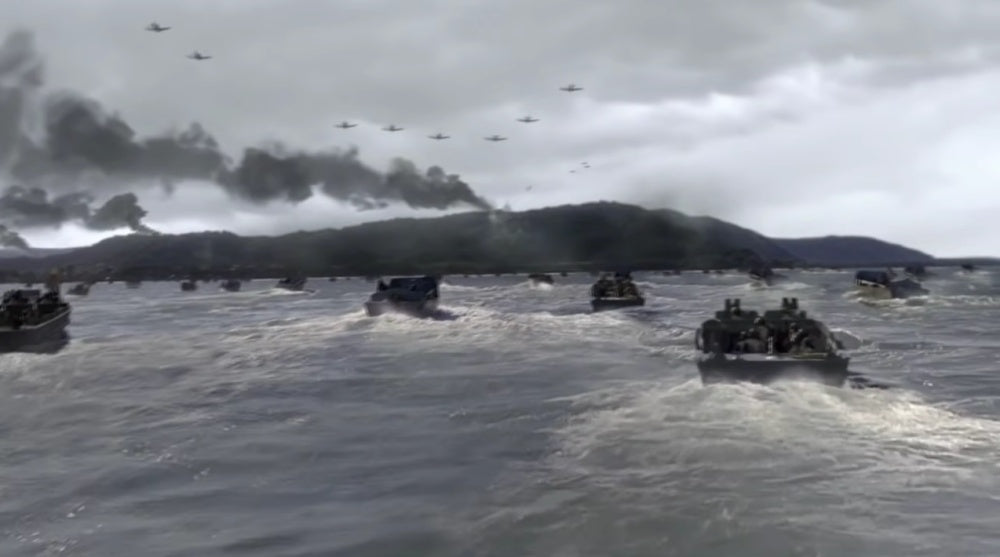Guadalcanal: The Beginning of The End For Japan
Dan Doyle
During the 1st six months of WWII, the Japanese had conquered vast territories in Asia and the South Pacific. They felt themselves to be undefeatable and were supremely confident about their efforts to continue to take territory. One of the most distant islands from their mainland that had become theirs was the island of Guadalcanal.
The Japanese felt now that they could control the commercial and military sea routes between Asia and the United States, and nothing was going to stop them. But to their great surprise, the Americans were suddenly at their doorstep with a naval fleet and the 1st Marine Division. They thought such an occurrence this early in the war would never happen.
 Photo: YouTube/HBO
Photo: YouTube/HBOOn the night of August 7, 1942, the Marines of the 1st Marine Division went ashore, their heads full of thoughts about the military toughness of the Japanese, who had defeated the Chinese and the Russians already. This was the first amphibious landing American troops had conducted since the Spanish American War in 1898. There were no 'veterans' who had participated in such a tactic. No one really knew how it would go.
The first wave of Marines came ashore, followed only minutes later by another wave. The second wave found the first wave of Marines sitting on the beach laughing at them coming ashore. It turns out that the Japanese forces on Guadalcanal at that time were labor forces who fled immediately. As it turned out, there were only about 200 Japanese combat troops on the island when the Marines landed. But the Japanese could move combat forces and supplies to Guadalcanal from other nearby islands like Bougenville quickly and would begin to do so shortly thereafter.
 Photo: YouTube/HBO
Photo: YouTube/HBOThe ground battle began in earnest for the Marines on August 21. The Japanese were somewhat disorganized and thought there would only be a small defensive force of Marines to meet. The Marines had dug in and were prepared for the Japanese troops and decimated them as they came up the beach. In the morning, the beach was littered with countless Japanese bodies.
The Marines knew though that it was only the beginning and this kind of thing would have to be done all over again. The Marines learned a couple of scary things in those first hours of battle. The individual Japanese soldier would never surrender, and even those that appeared to surrender were only doing so to get close enough to kill one more Marine. But their efforts to counterattack and retake Guadalcanal failed.
 Photo: YouTube/HBO
Photo: YouTube/HBOThe airfield was the main target of Japanese bombers and fighters. It was the main goal of the Marines to keep Henderson Field, and they did. It never returned to the Japanese, and the Marines repaired it every time it was damaged for use by American Naval and Marine Corps planes.
By December 9th, the battle was pretty much over but for small actions. The first elements of the 1st Marine Division began to leave Guadalcanal for some needed rest. By this time, they were physically and emotionally exhausted from the intensity of the fight.
 Photo: YouTube/HBO
Photo: YouTube/HBOThe naval battle began on the night of November 13, 1942, and it would be an incredibly bloody exchange, with both sides causing massive damage and losses to the other. The Marines on Guadalcanal, and presumably the Japanese too, could see the flashes of the big guns out in the dark, and they could see ships exploding but could not tell who was winning. What they were all too aware of was that a hell of a battle was going on out there.
The battle was so intense for both sides that the area of ocean it was fought on became known to the Americans as "Iron Bottom Sound" because of the number of ships that went to the bottom during that night. The U.S. Navy would see the cruiser USS Atlanta and the USS Juneau sunk. The USS Juneau is the ship on which the five Sullivan brothers served, and all of them were killed in that battle. This would give rise to the military policy known as the "Sole Survivor Policy," which made it no longer possible for siblings to serve in combat together.
https://www.youtube.com/watch?v=mJMlH1xRLd4
1,400 American sailors were KIA during the night, and thousands more were wounded. Dozens of warships from both sides would be sunk or severely damaged. The next morning, the Marines looked out onto an empty horizon. The Navy had pulled away from Guadalcanal to resupply, reorganize, and lick their wounds. The Japanese then began to bring in combat troops and supplies to push the Marines off the island. One of the surviving U.S. Navy officers described the sea battle that night as being like "a barroom brawl after the lights were turned out."
 Photo: YouTube/HBO
Photo: YouTube/HBOThe Battle of Guadalcanal was the beginning of the end for the expansionist efforts of the Japanese Imperial forces. It was the first of the islands to fall to American and allied forces. From then on, each and every one of the subsequent battles would be even more intense and bloody.
We owe all those who fought at Guadalcanal a debt of gratitude that is beyond calculation. The Marines of the 1st Marine Division and the sailors of the U.S. Naval fleet who fought there met a determined and powerful enemy and won at great cost. Their courage, their fight, and their success really was a turning point in WWII in the Pacific Theater. February 9, 1943, 80 years ago, the Battle of Guadalcanal was declared officially over.
https://www.youtube.com/watch?v=KQKJY43-LmE

Dan Doyle is a husband, father, grandfather, Vietnam veteran, and retired professor of Humanities at Seattle University. He taught 13 years at the high school level and 22 years at the university level. He spends his time now babysitting his granddaughter. He is a poet and a blogger as well. Dan holds an AA degree in English Literature, a BA in Comparative Literature, and an MA in Theology, and writes regularly for The Veterans Site Blog.




















